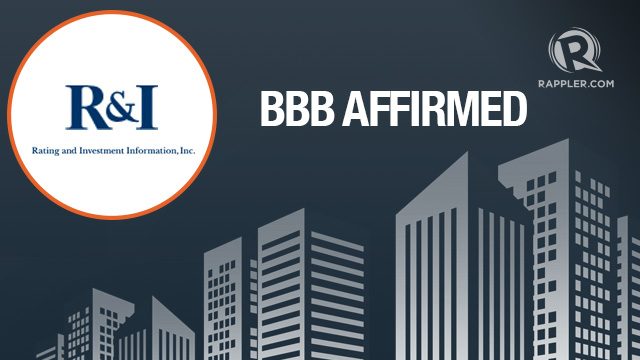SUMMARY
This is AI generated summarization, which may have errors. For context, always refer to the full article.

MANILA, Philippines — Japan’s debt watcher Rating and Investments Information, Incorporated (R&I) has affirmed its grade and outlook on the Philippines, citing continued improvements in the country’s economic fundamentals.
But the Philippines’ Department of Finance (DOF) said “the country’s rating should be higher.”
In a statement on Thursday, July 30, R&I affirmed the country’s long-term foreign currency issuer rating to BBB, giving it a “stable” outlook.
“The Philippines’ economy continues to grow at a solid pace of over 6%,” R&I said. “In addition to private consumption, which has been the primary driver of the economy, brisk investment has contributed to the growth in the past couple of years.”
The debt watcher affirmed the Philippines’ rating as risks are limited in terms of both fiscal and external positions. (READ: INFOGRAPHIC: What a credit rating upgrade means for Filipinos)
The latest investment grade from R&I, however, is not what the DOF expected.
According to Finance Secretary Cesar Purisima, “the Philippines’ economic prospects remain one of the best within the emerging markets sphere.”
“Since 2010, we have proven that good governance is good economics,” he said in a statement.
The Japanese debt watcher said it retained the rating as “capital flows are projected to be affected somewhat by an interest rate hike in the US.”
Despite the impact from the US’ interest rate hike, the ‘BBB’ rating was affirmed as “R&I does not believe that the Philippines’ economic fundamentals will deteriorate significantly.”
The debt watcher first issued the scores and the outlook in July 2014.
Economy in ‘far better shape’
But for Purisima, the economy that will be handed over to the next administration is “in a far better shape” than it was 5 years ago.
“When President [Benigno] Aquino [III] steps down in 2016, he will bequeath to the next administration an economy with sound macroeconomic fundamentals: high growth, low inflation, manageable deficit and debt burden, and resilient external accounts,” he said.
“Our leg of the relay race is almost over; we have the resolve to finish the run beautifully,” Purisima added.
The finance secretary said the Aquino administration institutionalized a host of economic and fiscal reforms that will ensure that these gains will be sustained.
‘Stable’ rating outlook
For Japan’s R&I, it affirmed its outlook on the Philippines’ long-term rating to “stable” as its share of investment in gross domestic product (GDP) is still the lowest among neighboring countries, even if it is increasing.
In 2014, the Philippines’ share of investment in GDP was about 22% in 2014.
Per-capita income levels also remain low compared to other major Association of the Southeast Asian Nations (ASEAN) members, according to the debt watcher.
R&I explained that “if the Philippines sustains solid growth and makes steady progress in raising per-capita income, it will likely have a positive impact on its creditworthiness.”
Given the goal of increasing infrastructure investments to at least 5% of GDP by 2016, R&I said eyes should continue to be kept on its capability to expand revenue sources and execute policies efficiently. – Rappler.com
Add a comment
How does this make you feel?
There are no comments yet. Add your comment to start the conversation.